�
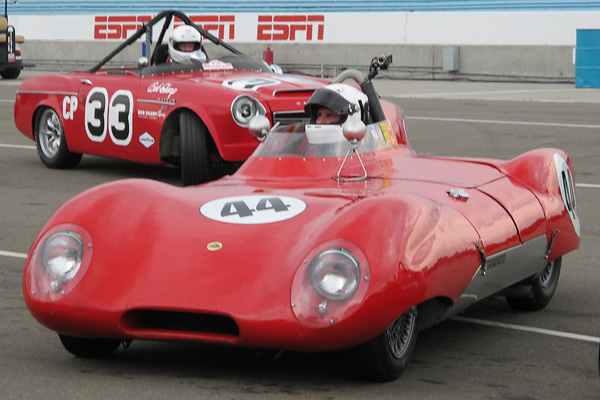
�
Glenn Stephens's 1956 Lotus Eleven LeMans Racecar
� � Owner: Glenn Stephens� City: Alpharetta Georgia
� Model: 1956 Lotus Eleven LeMans
� Engine: 1.4L Climax four-cylinder
� Race prepared by: Brian MacEachern�
�
Introduction
��
Glenn Stephens started his racing career in SCCA's Spec Miata class back in 2004. Spec Miata is an�
attractive "drivers class" because it offers hard-fought battles between large fields of evenly-matched�
cars, and because it's relatively cheap to get into. The downside of spec racing is the sameness.�
Nearly all racing is exciting viewed from a drivers seat, but history's greatest races have been�
between mismatched cars. Can the nimble overtake the powerful when the road gets twisty? Will the�
heavier car's brakes fade in the final laps? Those are just two examples of the myriad technical�
questions that take racing from a tactical exercise to a strategic one. When cars are mismatched,�
drivers are obliged to exploit the advantages of their own equipment or the weaknesses of rival racecars.�
Glenn still runs a Spec Miata four to six weekends per year, but he added a lot of spice�
to his life when he purchased a 1956 Lotus Eleven Le Mans.�
�
�
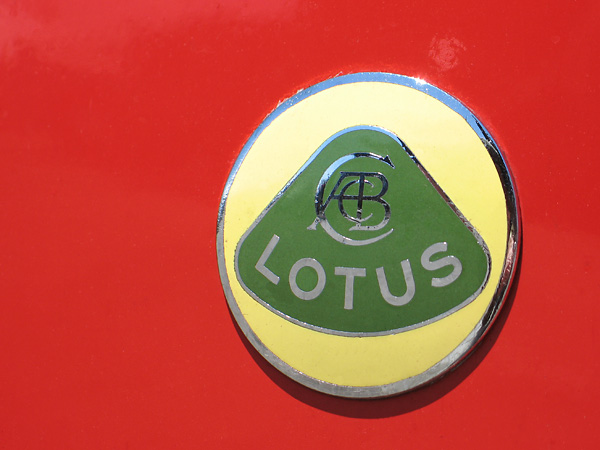
�
The initials of founder Anthony Colin Bruce Chapman appear above the marque name.
�
�
We've written about the Lotus Eleven's place in history before, here.�
For now we'll just summarize that the Eleven transformed Colin Chapman's company. The Eleven�
was successful at all levels of motor racing from amateur races in the hinterlands right up to�
class and "Index of Performance" victories at Le Mans and at Sebring. Lotus had built less than�
fifty cars before the Eleven. Lotus Eleven production came to 270 cars. �
�
Glenn Stephens' car was built near the end of the Eleven model's first year of production: 1956.�
It was delivered in 1957. Now that was a great year for British race cars! In the 24 Hours of�
Le Mans endurance race, Jaguar D-Types finished first through fourth. Lotus didn't yet produce a�
car for large-displacement racing classes, but they brought home their share of trophies anyhow.�
At Le Mans, Lotus fielded a team of three Elevens.�
Mac Fraser and Jay Chamberlain drove one 1100cc Eleven to 9th overall and 1st in Class G.�
Robert Walshaw and John Dalton drove a second 1100cc car to 13th overall and 2nd in Class G.�
Cliff Allison and Keith Hall drove a 750cc car to 14th overall and 1st in Class H, plus they won�
the coveted Index of Performance! In other words, their car was both quick and fuel efficient.�
Amazingly, the Fraser/Chamberlain Eleven finished second in the Index of Performance competition�
despite its larger engine. In a race so tough that only 21 of 54 entries finished, Lotus�
surpassed all expectations. �
�
Forty-eight years later, one of Glenn's Spec Miata racing buddies came across three Lotus Elevens�
in a North Atlanta warehouse. Three similar cars, parked in a neat row, gathering dust. He called�
Glenn over to have a look, and Glenn fell in love. Upon further research, it was discovered that one�
of the three Elevens had formerly belonged to television news anchorman Walter Cronkite. Another of�
the three - a Le Mans spec car in polished aluminum bodywork - had been driven on the street in�
Atlanta for years. But it was the third one that really captured Glenn's interest. Problem number�
one: its owner wasn't particularly motivated to sell it. He was, at least, willing to discuss it.�
�
�

�
Lotus Engineering Co. Ltd.
�
7 Tottenham Lane, London, N.8., England
�
Chassis No. MK11/283, Engine No. 6986
�
Please support the sponsoring companies who make www.BritishRaceCar.com possible, including:
� �
 �
�
�
�
Lotus Eleven Chassis Number 283
��
Chassis number 283, was originally shipped to U.S. distributor Jay Chamberlain in Los Angeles.�
Lotus Eleven serial numbers started at #150 and were then sequentially assigned, so chassis�
283 was nominally 133rd of the 150 Series 1 cars built. (There were also sixteen Series 1.5�
cars, and 104 Series 2 cars.)�
�
�
Number 283 had been raced occasionally in the early sixties, on the west coast. However,�
it couldn't have been raced too hard because it remained remarkably original. In the 1980s,�
as vintage racing rapidly grew in popularity, number 283 was freshened up and raced again.�
Once again, it probably wasn't raced too hard before going into dry storage for another twenty�
years. It was a case of "ran when parked". The owner imagined that it would only need a day or two�
of work to put it back on track. Glenn reasoned every single seal and hose would certainly need�
replacement, and it would only be prudent to inspect and magnaflux anything that might�
crack or break in battle. They couldn't agree on a price. Once Glenn volunteered to donate�
his labor, the owner agreed that the car could be taken apart and inspected. �
�
Cleaned, visually inspected, and all back together with new bearings and seals... but still no�
agreement on a price. Glenn raised his offer, but not enough. The owner hired an agent to market�
the Eleven all over England, failed to find a buyer there, and finally came back to accept Glenn's�
offer. Glenn took possession, and turned chassis 283 over to Lotus Eleven specialist Brian Maceachern�
for further race preparation. Glenn's Eleven would be ready to race in 2006.�
�
�
Enjoying this article? www.BritishRaceCar.com is partially funded through generous support from readers like you!
�
To contribute to our operating budget, please click here and follow the instructions.
�
(Suggested contribution is twenty bucks per year. Feel free to give more!)�
How Does a Lotus Eleven Compare to a Mazda Miata?
��
Glenn reports that his two racecars set remarkably similar lap times at most tracks.�
The Lotus has a couple clear advantages at faster tracks: less aerodynamic drag and�
less rolling resistance too. The Miata has advantages at shorter circuits where �
wider tires and the ability to hop curbs help the car retain speed through corners.�
�
The (Series One) swing arm front suspension makes the Lotus a bit tricky to drive.�
As you go through a sweeper, the off-side tire droops to an off-camber angle. Then,�
when you come out of the turn it has to stand back up and it�
gives a disconcerting little wiggle. Another thing that's weird is that you're sitting�
over the rear axle, so your steering effort seems to be happening a long way away.�
Oversteer (i.e. the rear end stepping out) is detected immediately and tends to feel�
more excessive than it really is. And you're on narrow bias-ply tires with tubes.�
The car naturally likes big slip angles, and wants to be driven in the old-fashioned�
drifting style. In this car, that's the only way to go fast. However, the front wheels�
don't have much wheel-cut and Glenn feels that limits how aggressively he can drift it.�
�
In the 50s most cars were very softly sprung. The Eleven came with 60 lbs/inch rear springs�
which Glenn has uprated to a whopping 80 lbs/inch. They can be compressed by hand. This works�
for a light car but it allows for quite a bit of body roll. The roll gives the car great grip�
in high speed sweepers where suspension can compress and then hold on. While the car is light�
and tossable, fast back-to-back turns are really not its strength. Watkins Glen is good.�
So is Mosport. Road America should be great, but Glenn hasn't driven the Eleven there yet.�
�
Glenn typically does 4-6 vintage events per year plus 4-6 Miata events. Glenn took his�
1956 Lotus Eleven LeMans to the Monterey Historics this year.
�
 �
�
�
�
Features and Specifications
�| Engine: | �Coventry Climax FWB four cylinder engine, originally 1100cc but bored and stroked to 1490cc.�
Rebuilt by Brian MacEachern.�
Dual Weber 40DCOE carburetors on custom fabricated steel intake manifolds.�
Pipercross foam air filters.�
Lucas distributor with Pertonix Ignitor breakerless ignition.�
Bosch Ultra Premium spark plug wires.�
NGK B8ES spark plugs.�
Wet sump lubrication system.�
Oberg tattletale oil filter. | �
| Cooling: | �brass/copper radiator.�
Oil cooler. | �
| Exhaust: | �four into one stainless steel header. (No muffler.) | �
| Transmission: | �Taylor Race Engineering manufactured Austin Healey Sprite style�
4-speed gearbox with close-ratio gears and dog-rings. | �
| Rear End: | �3.90:1 ring and pinion. Quaiffe limited slip differential. | �
| Chassis: | �wheelbase 7'1", front track 3' 10.5", rear track 3' 11". | �
| Front Susp.: | �swing axle front suspension with KONI double adjustable shock absorbers.�
Hyperco springs rated 250 pounds per inch.�
1/8" toe-in. | �
| Rear Susp.: | �DeDion rear suspension.�
KONI double adjustable shock absorbers.�
Hyperco springs rated 80 pounds per inch.�
Rear hubs have been refreshed, and installed with oversize bearings.�
Panhard rod.�
1/16" toe-in. | �
| Brakes: | �(master) dual Girling 0.75" master cylinders with remote reservoirs. � (front) Girling AR brake calipers and 9.5" unvented rotors, mounted outboard. � (rear) Girling NR brake calipers and 9.5" unvented rotors, mounted inboard. | �
| Wheels/Tires: | �Dayton 72-spoke 15x5 wire wheels (in lieu of original 60-spoke Dunlop wheels).�
Dunlop Racing 204 bias-ply tires (4.50L-15 front, 5.0L-15 rear). | �
| Electrical: | �Tilton Super Starter.�
Odyssey PC925 battery. | �
| Instruments: | �(left to right)�
Lucas ammmeter (+/-30 amperes),�
Tudor water temperature gauge (90-230F),�
Traqmate Shift-I progressive gear shift and RPM range indicator,�
VDO electronic tell-tale tachometer (0-10,000rpm), �
Jaeger oil pressure gauge (0-100psi). | �
| Fuel System: | �custom fuel cell liner, installed in the original Lotus fuel tank.�
Electric fuel pump. | �
| Safety Eqmt: | �G-Force 5-point latch and link safety harness.�
Quick release hub mounted on a Moto-Lita steering wheel. �
ESS centralized fire suppression system.�
GT Classic mirrors. | �
| Weight: | �~990 pounds wet (which is about 10 percent more than original). | �
| Racing Class: | �SVRA 4FM | �
Engine Installation
��

�
Original Lotus Eleven bodywork by Williams & Pritchard Ltd.
�
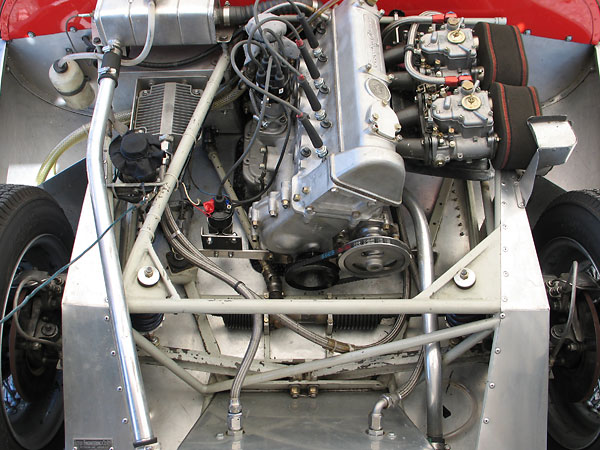
�
This Coventry Climax FWB four cylinder engine was originally 1100cc but it has been bored and stroked
�
to 1490cc. This is the car's second engine. Its original (Climax FWA) engine is kept in safe storage.
�
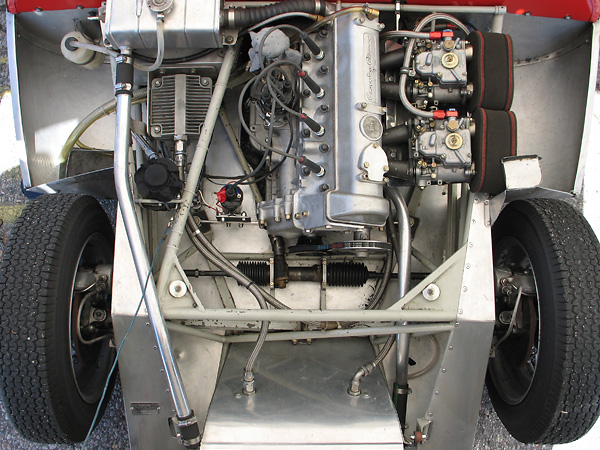
�
Notice that the Climax engine is tilted about ten degrees from vertical.
�
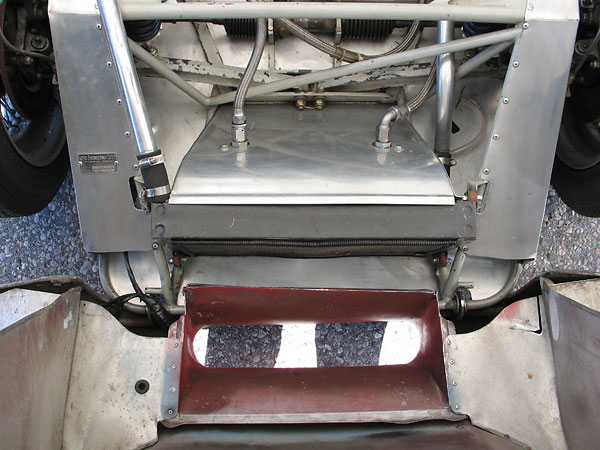
�
After passing through the radiator, air passes down rather than through the engine compartment.
�
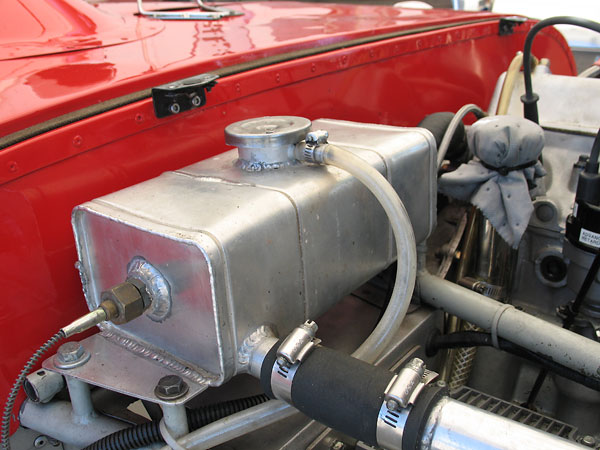
�
Correct Lotus coolant header tank mounted high to ensure the engine and radiator are fully filled.
�

�
Oberg tattletale oil filter. (The coolant overflow bottle at left is labeled "Trafalgar Product".)
�
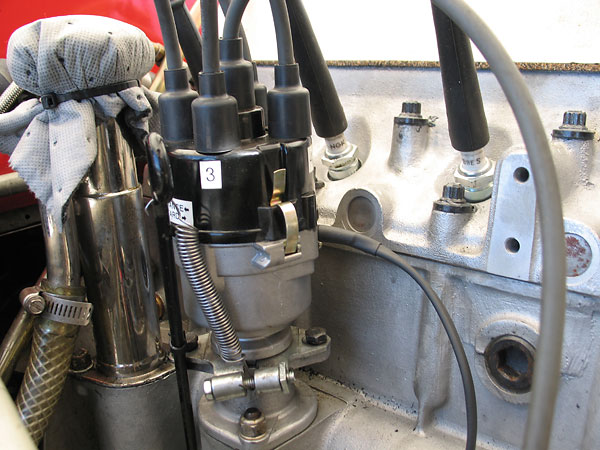
�
Lucas distributor with Pertonix Ignitor breakerless ignition. NGK spark plugs.
�
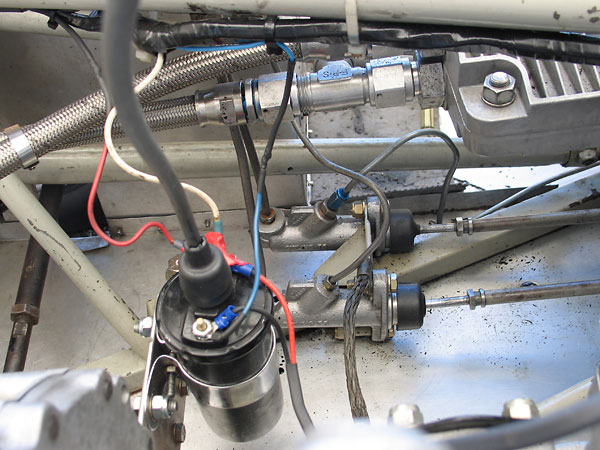
�
Dual Girling 0.75" brake master cylinders, supplied by a remote reservoir.
�
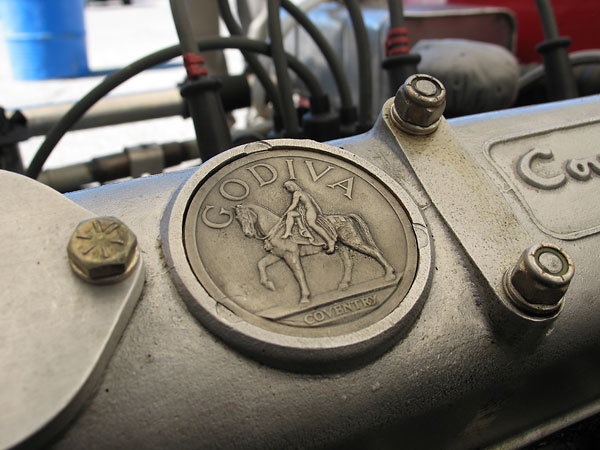
�
Godiva - Coventry
�
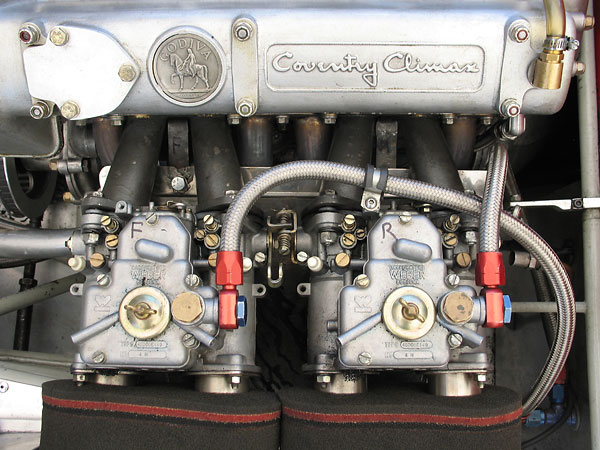
�
Dual Weber 40DCOE carburetors.
�
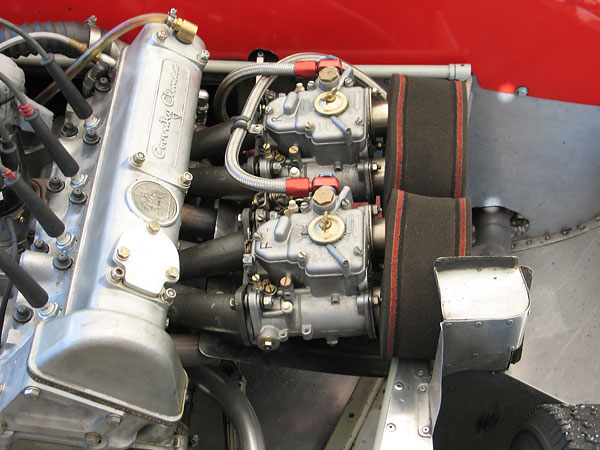
�
Custom fabricated steel intake manifolds.
�
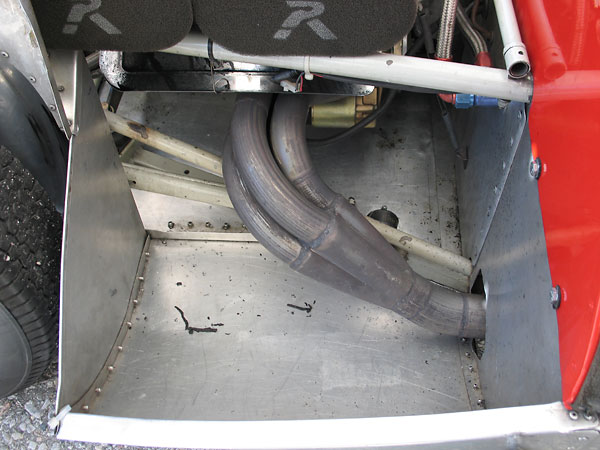
�
Four into one stainless steel header.
�
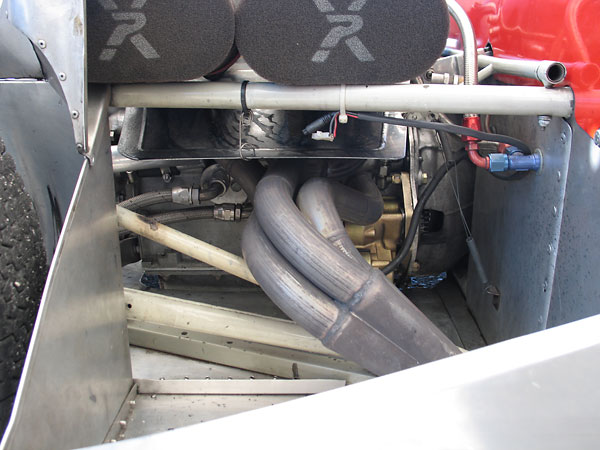
�
Between exhaust and carburetors, we can see an aluminum heat shield. Below, a Tilton Super Starter.
�
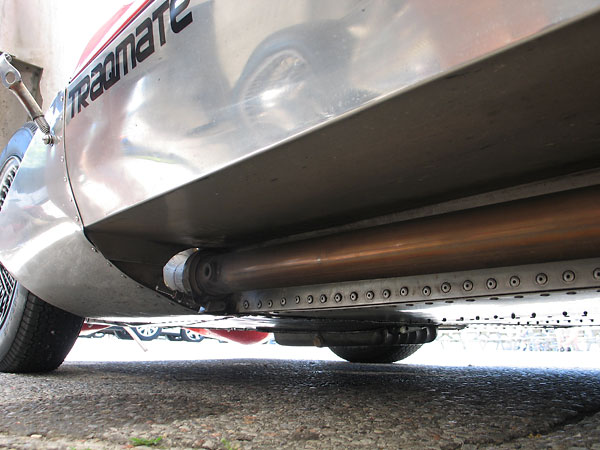
�
Wideband oxygen sensor bung on the exhaust pipe. A sensor placed here greatly aids engine tuning.
�

�
Stainless steel exhaust pipe.
�

�
Coventry Climax water pump.
�
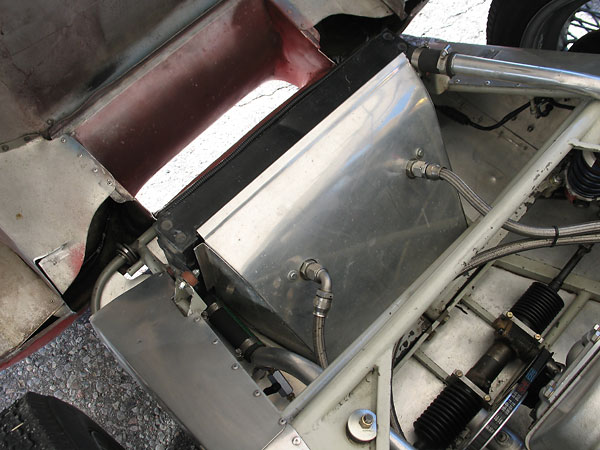
�
Engine oil cooler connections.
�
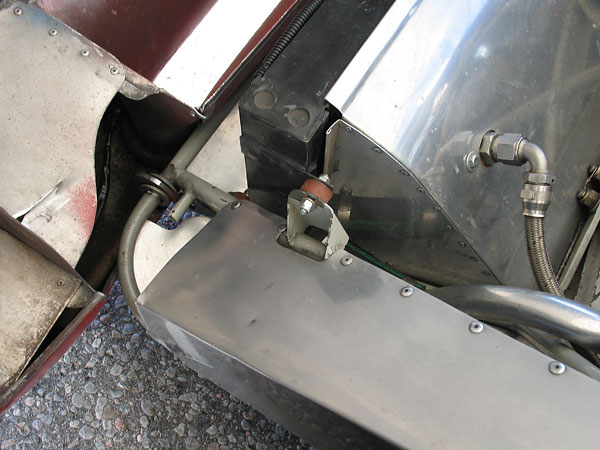
�
Vibration isolator on the radiator mounting bracket.
�

�
Convenient valve for draining the cooling system.
�
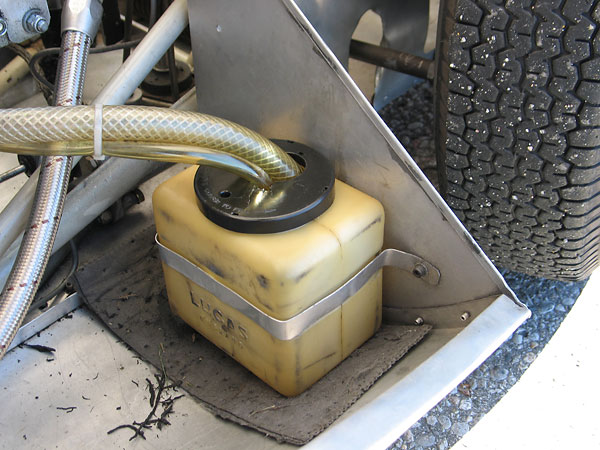
�
"Lucas England" windshield wiper fluid reservoir, repurposed as a engine vapor catch tank.
�
Front Suspension
��
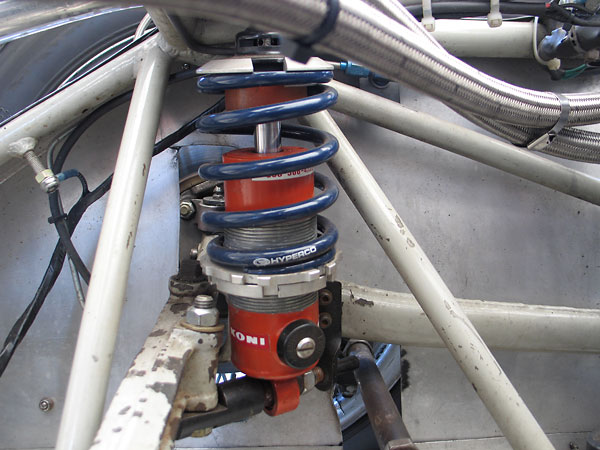
�
KONI double adjustable shock absorbers and Hyperco coil springs (250#/inch).
�

�
The modified Morris Minor steering rack shows casting number "133270".
�
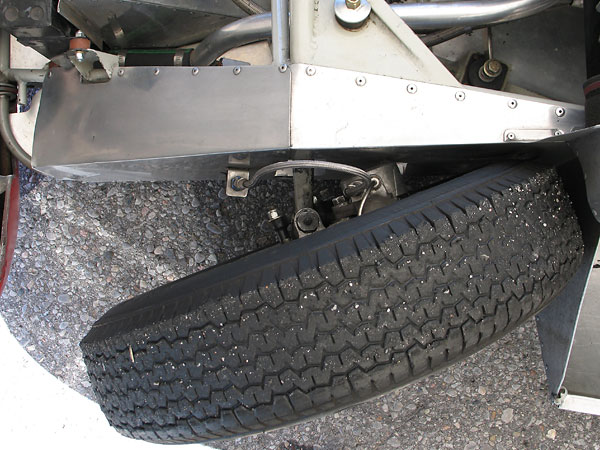
�
One compromise of the Lotus Eleven design is revealed here: limited wheel cut.
�
These cars are at their best on big sweeping turns. Very tight turns can be problem.
�

�
On most racecars, ride height is set by raising or lowering spring perchs on coilover shock absorbers.
�
On a Lotus Eleven Series 1, static camber changes as you raise or lower the car's swing axle front
�
suspension. When tuning the suspension, it's best to set the camber carefully but let ride height
�
fall where it may. Ride height typically measures 4.5" to 5" to the flat aluminum floorpan.
�

�
Girling AR brake calipers and 9.5" diameter solid rotors. Forged steel steering arms.
�
�
Rear Suspension
��

�
Aluminum bodywork tilts rearward or lifts off to provide service access to the rear suspension.
�
Club and Sports versions of the Lotus Eleven were built with solid rear axles, but the Le Mans
�
variant came standard with a de Dion rear suspension. In either case, mounting points on the
�
frame were identical. Coilover shocks and suspension links were similar too.
�
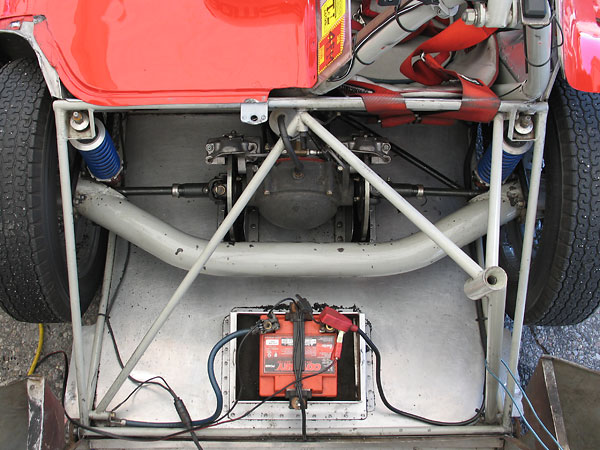
�
The Eleven LeMans' de Dion tube is located by four horizontal trailing links plus a fifth rod which
�
angles forward from the righthand hub carrier diagonally to the driveshaft tunnel. Functioning
�
like a Panhard rod, this member keeps the de Dion tube centered relative to the body and it also
�
determines the axis about which the body rolls when cornering. That this axis is off-center a
�
little to the righthand side doesn't seem to be a problem.
�
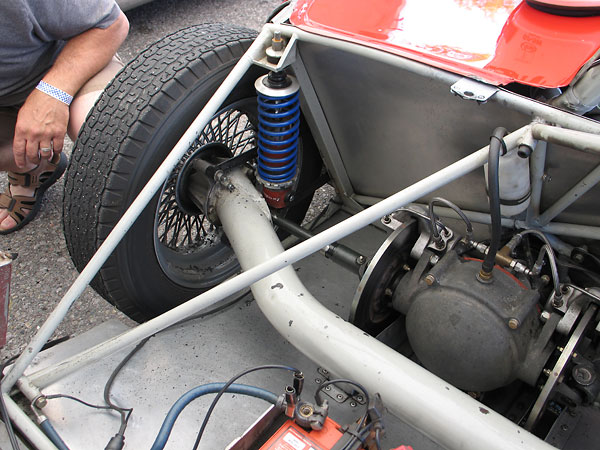
�
Lotus press releases mentioned their design intent of achieving less understeer than previous
�
models while minimizing roll stiffness. Relatively high roll centers were selected to make
�
this approach practical. The Lotus Eleven's front roll center is located 5.75" above the
�
ground, and the rear roll center is located 9.5" above the ground.�
�
Very soft springs are another key aspect of the Lotus Eleven design. Glenn compares
�
the rear springs to Slinkey toys, but in fact he has uprated his springs from stock.
�
Original specification was 60 pounds/inch. Glenn prefers 80 pounds/inch.�
�
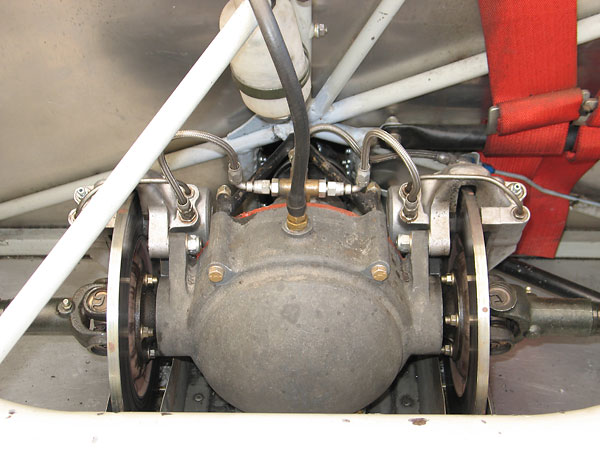
�
Lotus created their own cast magnesium alloy differential carrier to house standard B.M.C. internal
�
components. The following gear ratios are available: 5.375:1, 5.125:1, 4.875:1, 4.55:1 (which was
�
standard on the Lotus Eleven), 4.22:1, 3.89:1, 3.73:1. Note also: Girling NR brake calipers
�
and solid 9.5" rotors, mounted inboard, with air ducted up through the floor for cooling.
�
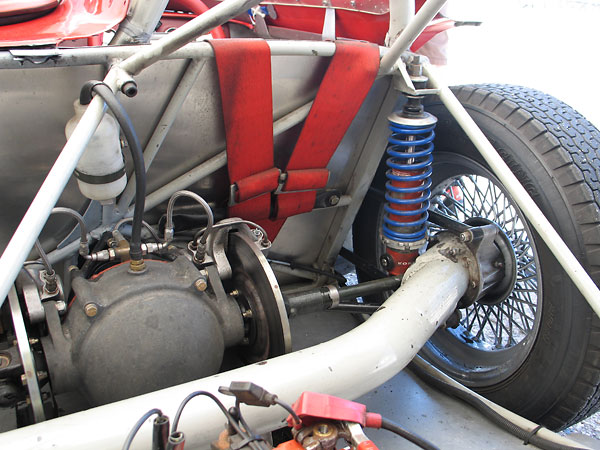
�
Now here's a revelation: the Lotus Eleven LeMans de Dion tube provides adjustable toe-in! How?
�
If you squint really hard, you might just see that there's a thin washer-shaped aluminum spacer
�
between the steel de Dion tube and the cast magnesium hub carrier. The spacer is tapered from
�
3.1mm on one edge to 1.5mm on the opposite edge. Although only six bolts secure the carrier
�
to the tube, the spacer has twelve holes. It can be indexed to provide accurate alignment or
�
alternatively a specified amount of toe-in. Glenn likes 1/16" of toe-in for the rear tires.
�
This method of toe-in adjustment alters camber too, but not enough to cause concern.�
�
Drive hubs were among the weakest aspects of the original Lotus Eleven LeMans. Their strength was
�
a recognized problem from early on, so most Lotus Eleven racecars were fitted with upgraded hubs
�
many years ago. When Glenn got his Eleven, he didn't know. He had his hubs magnafluxed, but they
�
were the original design. One broke while he was going 84mph at Road Atlanta in 2006, sending him
�
careening off the track. (How does he know it was 84mph? Traqmate!) That scary incident prompted
�
a careful re-evaluation of critical running gear such as hubs, wheel bearings, wheels, etc.�
�

�
Glenn's Lotus Eleven still has it's original frame, and it's almost completely un-modified.
�
There are a couple conspicuous exceptions: the small horizontal tube that the shoulder
�
straps mount to and this nifty roll hoop support structure.
�
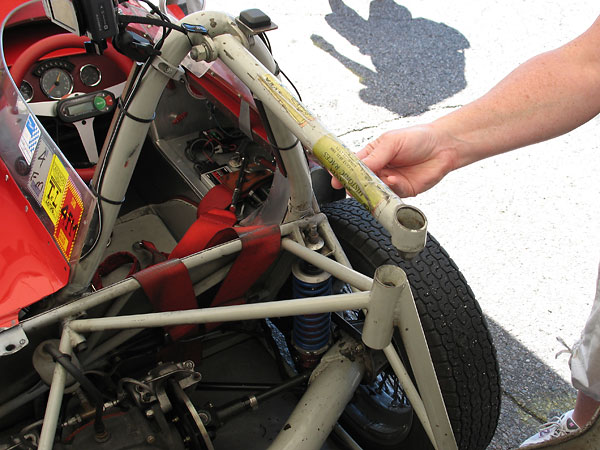
�
The rearward roll hoop brace ends at a cone and socket connection.
�
�
Interior
��
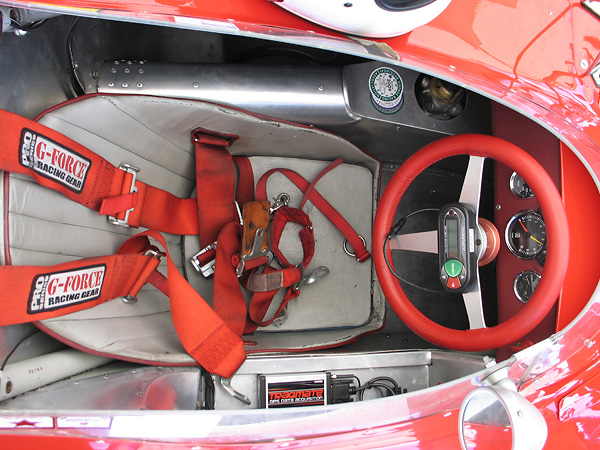
�
G-Force Racing Product Pro Series 5-point latch and link safety harness. This harness meets SFI 16.1
�
requirements, but not the FIA 8853/98 standard. SFI 16.1 is an American standard which can be met
�
with nylon fabrics that break down quickly in sunlight. Nylon harnesses must be replaced after two
�
seasons from their date of manufacture. FIA 8853/98 is a global standard which explicitly requires
�
polyester fabric. Polyester harnesses may be used for five years from date of manufacture.
�

�
Traqmate GPS Data Acquisition controller.
�
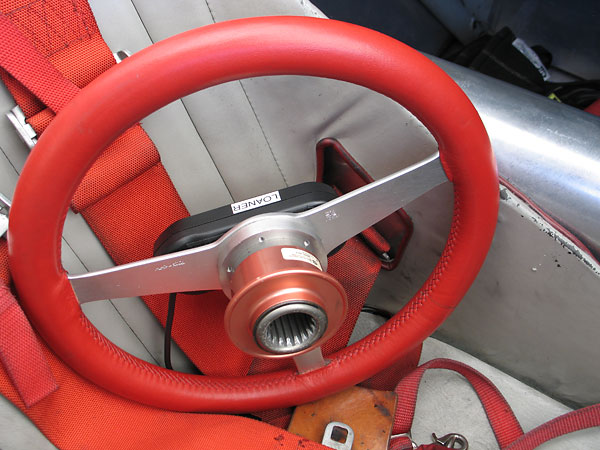
�
Quick release hub mounted on a Moto-Lita steering wheel.
�
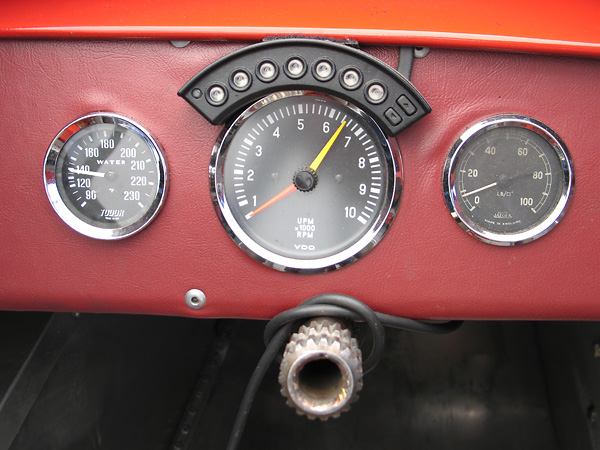
�
Traqmate Shift-I progressive gear shift and RPM range indicator installed atop a VDO tachometer.
�
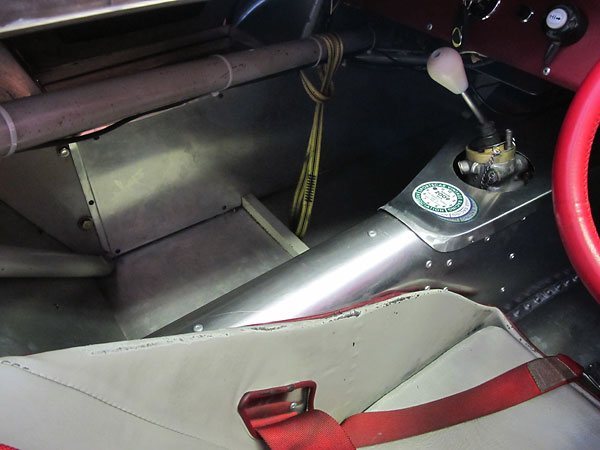
�
The driveshaft tunnel isn't just a cover, it's an important part of the Lotus Eleven Le Mans chassis.
�
The differential housings is connected to it, and it's responsible for absorbing reaction torque.
�
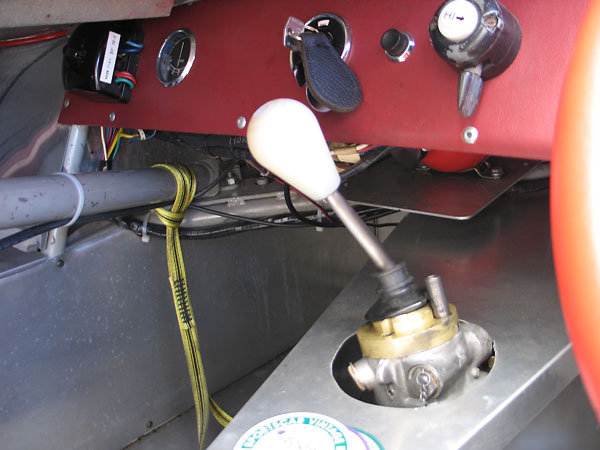
�
Taylor Race Engineering Sprite 4-speed with close-ratio gears and dog-rings. Lotus originally
�
used Austin A30 gearbox housings (similar to MGA) and gear shifters except with custom internal
�
components. They claimed 30 pounds of weight reduction from stock. Gear ratios as provided by
�
Lotus: 2.5:1, 1.67:1, 1.23:1, 1:1, plus 2.5:1 for reverse.
�
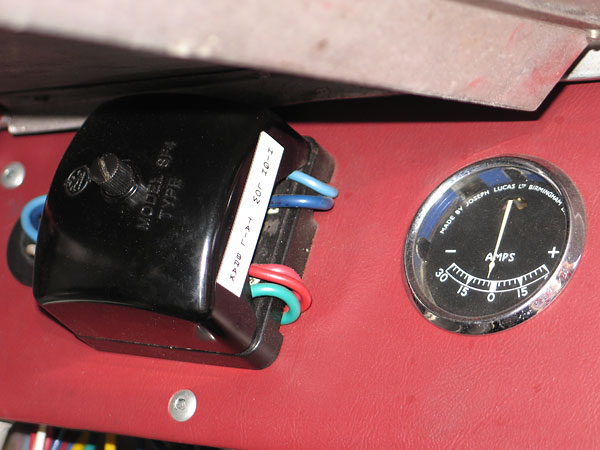
�
(left) Lucas model SF4 fuse block and (right) Lucas ammeter.
�
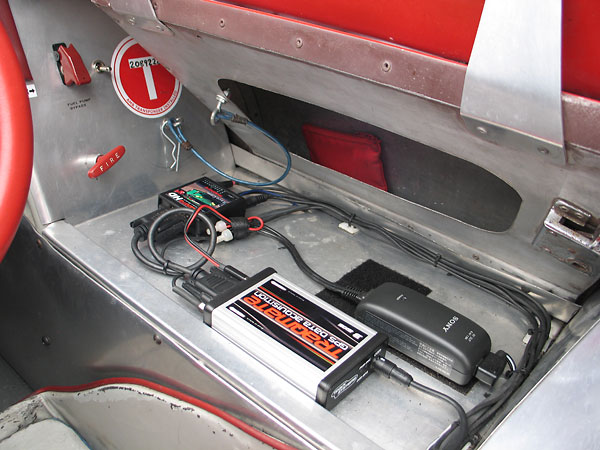
�
Traqmate GPS Data Acquisition "uses a high-speed GPS receiver and high resolution
�
accelerometers to track and record the speed of a vehicle, its absolute location, and forces
�
acting on the vehicle. The Traqview analysis program uses advanced mathematical algorithms
�
to translate this data into visual form where it is easy to spot differences between drivers,
�
vehicles, and sessions. It's extremely easy to use and very powerful."
�
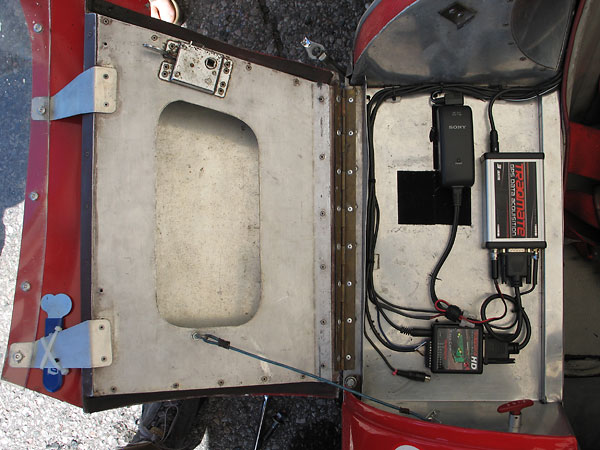
�
Traqcam HD: "integrated data and video products will collect synchronized data and HD video
�
and play it back using the award-winning TraqStudio software. You can zip to any place on the
�
track and the video will follow it. You can play in slow motion, fast motion, or single step with
�
cool overlayed gauges. With your data and HD Video in sync you can quickly analyze your
�
driving and Learn to Go Faster!"
�

�
The brake pedal actuates two separate master cylinders through a pivoting intermediary bar.
�
Gross changes of brake bias can be made by resizing one master cylinder or the other, whereas
�
fine bias changes can be made by shifting the brake pedal connection left or right on the bar.
�
In a few years time, much more refined bias bar mechanisms would become de riguer.
�
Also: stock Lotus Eleven steering columns rotate on nylon bushings, in rubber mounts.
�
�
Exterior
��
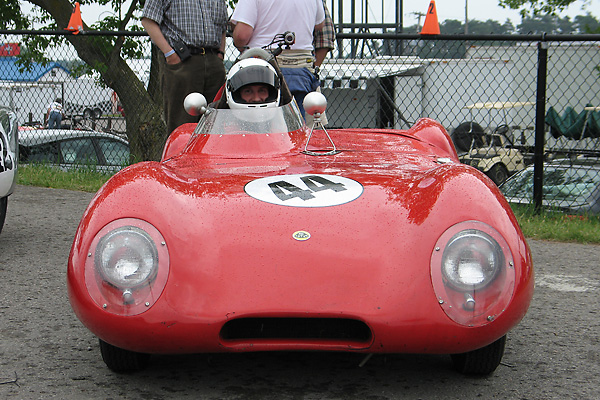
�
We enjoyed watching Glenn compete in VARAC's 31st International Vintage Festival at
�
Mosport International Raceway on June 20, 2010. He lapped the challenging 2.458 mile
�
track quite quickly at 1:40.136 for an average speed around the circuit of 88.37mph.
�

�
Glenn's Eleven (#283) and its stable mate, Brian MacEachern's Eleven "Silver Bullet" (#224).
�
At Mosport, in a sixteen lap sprint race, these two lapped 53 competitors in a 58 car field.
�
Just three Mini Coopers remained on the lead lap, about one minute back from the Elevens.
�
In fact, the two Lotus Elevens flew past most of the field twice!
�

�
These two cars and their drivers are evenly matched. Watch for a great race when they meet.
�
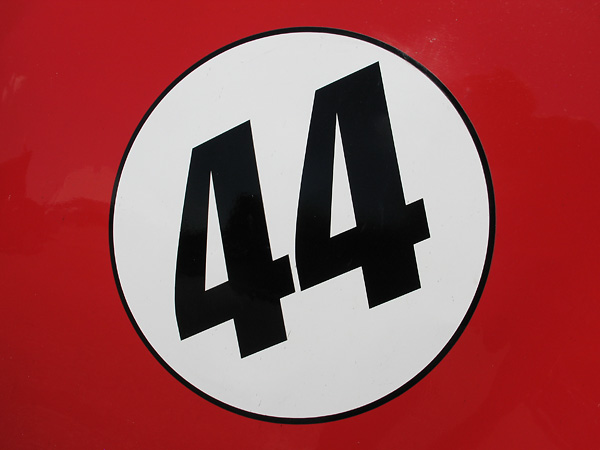
�
Glenn ranks Mosport and Watkins Glen as his two favorite tracks for the Lotus Eleven.
�
They're very fast tracks. Glenn can typically get his Lotus Eleven around Watkins Glen's
�
3.4 mile circuit in about 2:22.8, which works out to about 85.7mph.
�
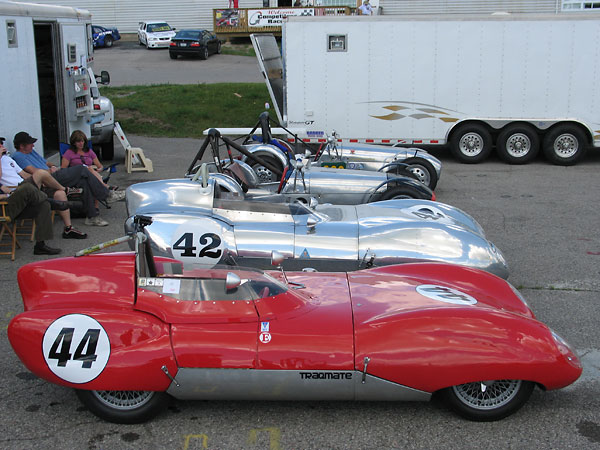
�
All Series One Lotus Elevens were originally equipped with spoked wheels. Cast magnesium
�
"wobbly web" wheels weren't offered as an option until the Series Two became available.
�
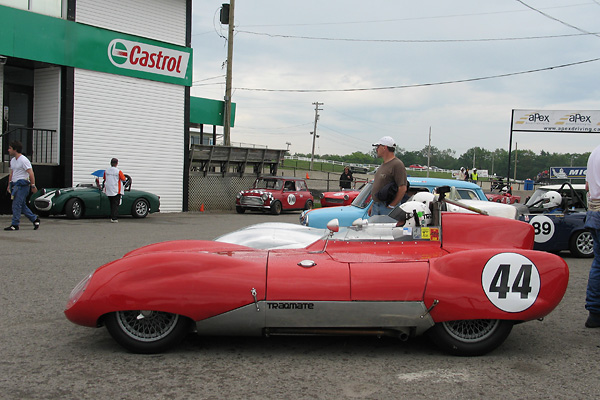
�
One great innovation and selling point of the Lotus Eleven design was the ease of removing body
�
sections to get at mechanical components underneath. Exactly two fasteners secure the front body
�
section to the car. When it's tilted open, it can be lifted off its hinges. Similarly, exactly two
�
fasteners secure the rear body section. Six screws secure the cowl cover to the frame.
�

�
Traqmate is the most popular GPS-based data acquisition system in auto racing.
�

�
Aluminum alloy tonneau covers with aerodynamic wrap-around Perspex windscreens were an available
�
option on all versions of the Lotus Eleven: "Sports", "Club", and "Le Mans" - from the start of production
�
until the end. Two two-seater windscreens were offered too: a tall model for road use and a
�
low-profile molded Perspex windscreen that mated to door-mounted extensions.
�

�
GT Classic mirrors.
�

�
A vintage style filler cap tops an authentic eight Imperial gallon aluminum fuel tank.
�
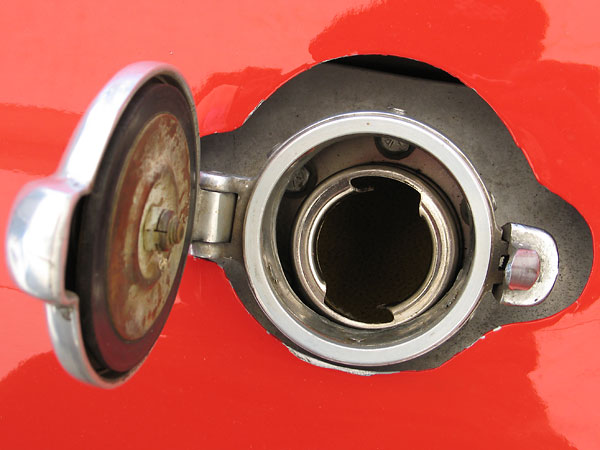
�
A modern fuel cell liner with a more secure filler cap is hidden underneath.
�
�
All except two of the photos shown here are from June 2010 when we viewed the car at VARAC's 31st Intl.�
Vintage Racing Festival at Mosport Motorsports Park, in Ontario Canada. The very first photo at the top�
of the article and also one photo of the car's driveshaft tunnel are from Watkins Glen, September 2011.�
Photos by Curtis Jacobson for BritishRaceCar.com, copyright 2012. All rights reserved.
�
| If you liked this article, you'll probably also enjoy these: | �|||||
 | �
Jeff Snook '56 Lotus XI LeMans | �
 | �
Dudley Cunningham '59 Lotus 15 | �
 | �
Tom Grudovich '60 Lola Sports Mk.1 | �
| You're invited to discuss anything you've seen here on The British Racecar Motorsports Forum! | �|||||
�
Notice: all the articles and almost all the photos on BritishRacecar.com are by Curtis Jacobson.
�
(Photos that aren't by Curtis are explicitly credited.) Reproduction without prior written permission is prohibited.
�
Contact us to purchase images or reproduction permission. Higher resolution images are optionally available.
�

 �
�